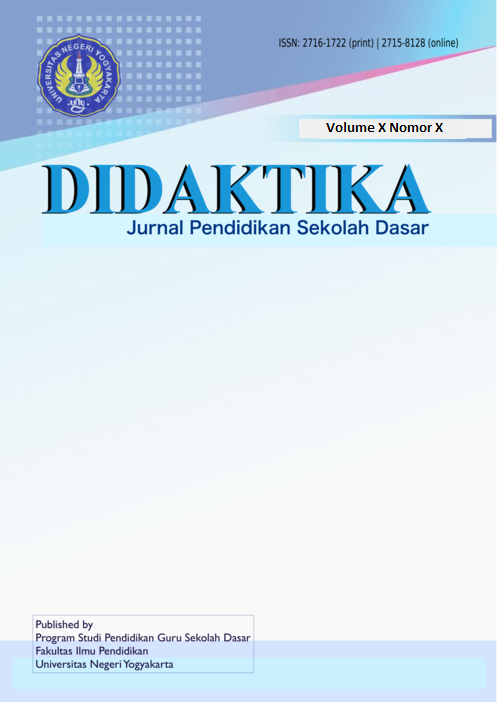Improving Responsibility and Mathematical Critical Thinking of Grade IV A Students of SDN Kentungan Through Contextual Learning Model
DOI:
https://doi.org/10.21831/didaktika.v4i2.41066Abstract
References
Fitri, Agus Zaenul. (2012). Pendidikan Karakter berbasis Nilai dan Etika di Sekolah. Jogjakarta: Ar-Ruzz Media.
Hamdayama,J. (2014). Model Dan Metode Pembelajaran Kreatif Dan Berkarakter.Bogor: Ghalia Indonesia.
Hosnan. (2014). Pendekatan Saintifik dan Kontekstual dalam Pembelajaran Abad 21. Bogor: Ghalia Indonesia.
Johnson, Elaine B. (2006). Contextual Teaching and Learning: menjadikan kegiatan belajar mengajar mengasyikkan dan bermakna. Jakarta: PT Bumi Aksara.
Kunandar. (2014). Penilaian Autentik (Penilaian Hasil Belajar Peserta Didik Berdasarkan Kurikulum 2013): Suatu Pendekatan Praktis Disertai Dengan Contoh. Ed. Rev. Jakarta: Rajawali Pers.
Kurniasih, I. dan Sani, B. (2014). Implementasi kurikulum 2013 konsep dan penerapannya. Surabaya: Kata Pena.
Kuswana, Wowo Sunaryo. (2012). Taksonomi Kognitif Perkembangan Ragam Berpikir. Bandung: Rosda.
Maulida. (2014). Pengaruh subject specific pedagogy tematik integratif terhadap karakter kedisiplinan, tanggungjawab, dan peduli lingkungan siswa kelas I sekolah dasar negeri 01 Singkawang Tengah Kalimantan Barat. Tesis. Yogyakarta: Program Studi Pendidikan Dasar, Program Pascasarjana Universitas Negeri Yogyakarta.
Mujis, D. d. (2008). Effective Teaching. Yogyakarta: Pustaka Belajar.
Muslich, M. (2007). Pembelajaran Berbasis Kompetensi dan Kontekstual. Jakarta: Bumi Akasara.
Narwanti, Sri. (2011). Pendidikan karakter. Yogyakarta: Familia.
Nurhadi. (2003). Pendekatan Konstekstual (Contextual Teaching and Learning). Jakarta: Depdiknas.
Priansa. (2017). Pengembangan Strategi & Model Pembelajaran. Bandung: Alfabeta.
Sanjaya. (2011). Model-model Pembelajaran. Jakarta: Bumi Aksara.
Sanjaya, Wina. (2013). Penelitian Pendidikan, Jenis, Metode dan Prosedur. Jakarta: Kencana Prenada Media Group.
Setiawan. (2014). Pendekatan ctl dalam meningkatkan kemampuan berpikir kritis siswa sekolah dasar pada mata pelajaran matematika. Diakses http://jurnal.stkippersada.ac.id/jurnal/index.php/jpimat/article/view/406. Diunduh pada 15 Februari 2021.
Shoimin, Ari (2014). 68 model pembelajaran inovatif dalam kurikulum 2013. Yogyakarta: Ar-Ruzz Media.
Suprijono. Agus (2009). Cooperative Learning: Teori dan Aplikasi PAIKEM. Yogyakarta: Pustaka Pelajar.
Susanto. (2013). Teori Belajar dan Pembelajaran di Sekolah Dasar. Jakarta: Kencana Prenada Media Group.
Rusman. (2016). Model-Model Pemblejaran (Edisi Kedua). Jakarta: PT Raja Gafindo Persada.
Undang-undang Republik Indonesia nomor 20 tahun 2003 tentang Sistem Pendidikan Nasional.
Zubaedi. (2011). Pendidikan Karakter: Konsep Dan Aplikasinya Dalam Lembaga Pendidikan. Jakarta: Kencana.
Downloads
Published
How to Cite
Issue
Section
Citation Check
License
- Authors retain copyright and grant the journal right of first publication with the work simultaneously licensed under a Creative Commons Attribution License that allows others to share the work with an acknowledgement of the work's authorship and initial publication in this journal.
- Authors are able to enter into separate, additional contractual arrangements for the non-exclusive distribution of the journal's published version of the work (e.g., post it to an institutional repository or publish it in a book), with an acknowledgement of its initial publication in this journal.
- Authors are permitted and encouraged to post their work online (e.g., in institutional repositories or on their website) prior to and during the submission process, as it can lead to productive exchanges, as well as earlier and greater citation of published work.






